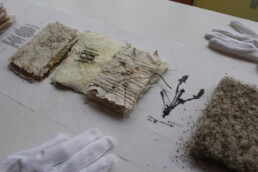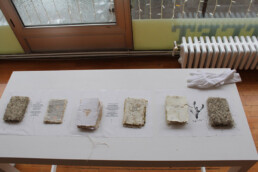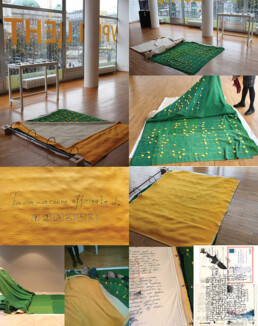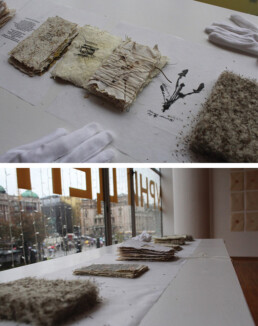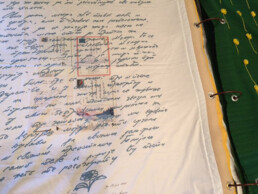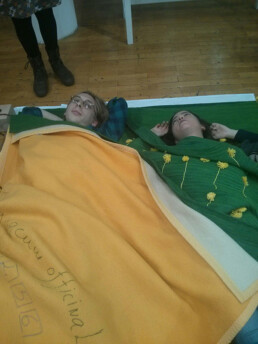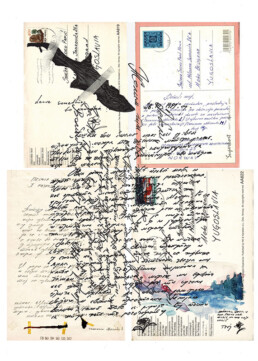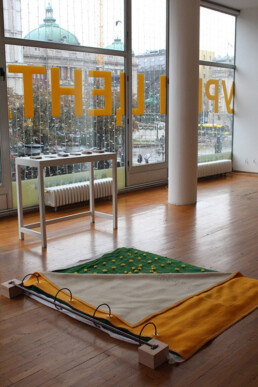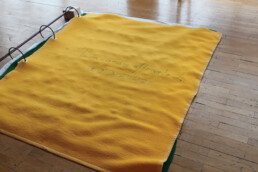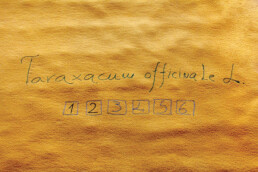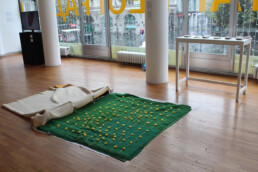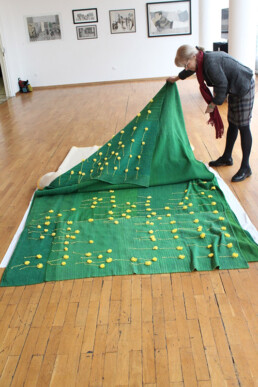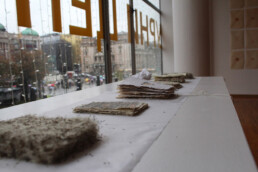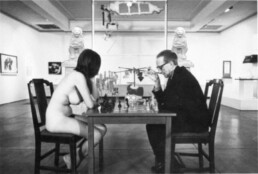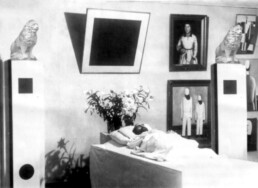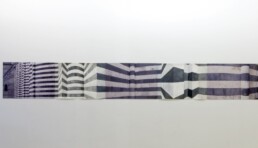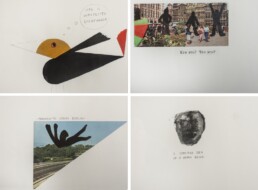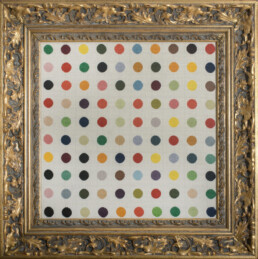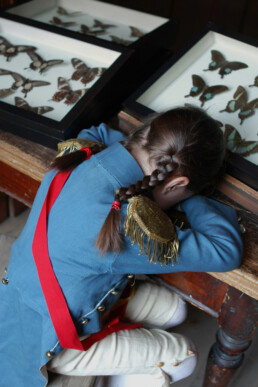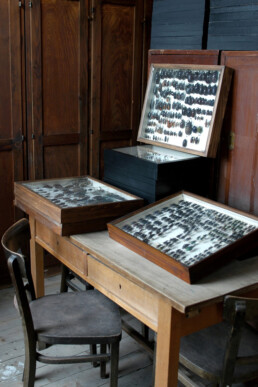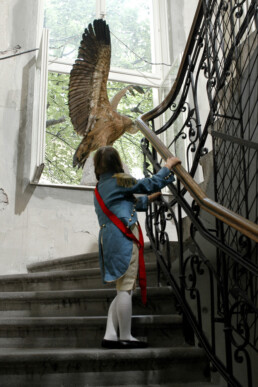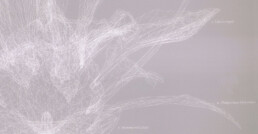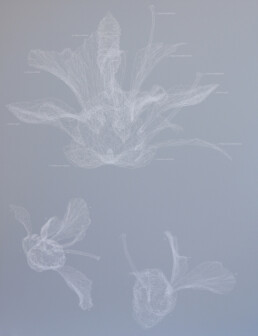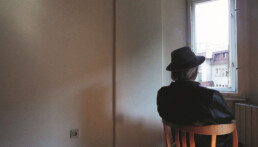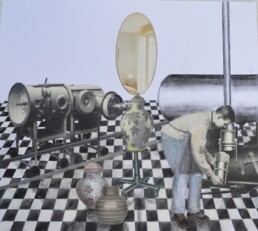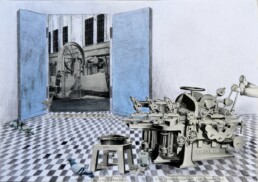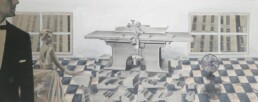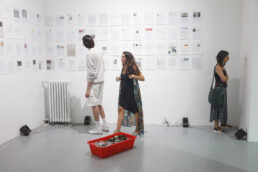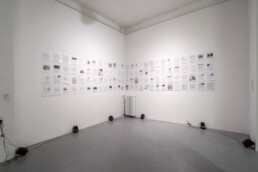NENA SKOKO
NENA SKOKO (1960)
“FAIRY-TALE ABOUT MIHAILO” CYCLE
- Taraxacum officinale L “1,2,3,4,5,6”
BOOK-BED (Love)
mixed media
190 x 150 x 20 cm
edition: single copy
1998/2016/2017
- “Young Man and Dandelion Flower”
BOOKS-MINIATURES (Young Man and Dandelion Flower, or The End that Was Not)
mixed media
six mini books, dimensions for each 10 x 7 cm
edition: single copy
1998/2016/2017
“FAIRY-TALE ABOUT MIHAILO” CYCLE
- Taraxacum officinale L “1,2,3,4,5,6”
BOOK-BED (Love)
mixed media
190 x 150 x 20 cm
edition: single copy
1998/2016/2017
- “Young Man and Dandelion Flower”
BOOKS-MINIATURES (Young Man and Dandelion Flower, or The End that Was Not)
mixed media
six mini books, dimensions for each 10 x 7 cm
edition: single copy
1998/2016/2017
The work was exhibited at the 56th October Salon, The Pleasure of Love, in 2016.
FAIRY-TALE ABOUT MIHAILO
Once upon a time there were a Young Man and a Dandelion Flower.
They were sincerely and deeply in love with each other.
They thought the greatest misfortune and obstacle to their love was their not being of the same kind.
Both at a certain point wished to be like the other.
By some incomprehensible magic their wishes came true.
The Dandelion Flower became a young woman,
and the Young Man became a dandelion.
Regardless of everything, the sun was still shining,
and winds kept blowing.
Nena Skoko Snežana
The greatest love stories are tragic… This work transcends touch – from the metaphor of the love bed, through walking a tightrope that forms a connection, to the touch that disappears like dandelion seed. These books can be leafed through, touched by hand, as well as by the whole body. Complete surrender in impossible circumstances turns lovers into clowns or tragic characters, and these two opposites are represented through the oxymoron of the most direct corporeality and delicately confined spirituality.
Ivana Podnar
Fairy-Tale about Mihailo
The topic I deal with is LOVE, my love story, partly real, mysterious, irrational, possible and impossible fairy-tale with a lesson. The topic is considered through five segments, five books which deal with the encounter, the kiss, love, parting, and the end respectively. Two of the books are presented here:
BOOK-BED (Love)
The yellow blanket with which I covered myself is also the cover of this book. Book pages are made of five blankets, which I wove and decorated with pom-poms, while the sixth page is a bed cover with Mihailo’s love letter printed on it. Counting from one to six was an expression of love for Mihailo and me.
BOOKS-MINIATURES (Young Man and Dandelion Flower, or The End that Was Not)
The leaves of mini books are made of parachuting dandelion seed and easy to tear apart and destroy. The impossibility of love and the end of Mihailo’s life made my love story develop towards a not merely unlovely ending, but also a tragically unhappy one. Common dandelion (Taraxacum officinale) is genus of weed. I don’t know if it can be uprooted.
Nena Skoko Snežana, excerpts from the 56th October Salon catalogue
© Cultural Centre of Belgrade, October Salon Collection and the artist
Purchase Contract: III-5-280/08.10.2021.
Inventory No.
Photo: 56th October Salon exhibition, courtesy of the artist
Selected Bibliography:
56th October Salon, The Pleasure of Love. Belgrade Cultural Centre, 2016.
ABOUT THE AUTHOR:
Nena Skoko Snežana (1960, Zemun, Serbia) completed her BA and MA studies at the Faculty of Applied Arts in Belgrade, Department of Textile Design. She received further education from professor Kirsti Rantanen at the University of Industrial Arts in Helsinki, during the student exchange programme organised by the Yugoslav and Finnish Ministries of Culture in 1989; at the Academy of Fine Arts in Poznan, where she studied under the mentorship of Magdalena Abakanowicz and Anna Goebel, with the scholarship from the Polish Ministry of Culture (1991-1993); at Goldsmiths in London, in 1994, where as a visiting graduate she worked with professor Janis Jefferies; in New York, where in 1999 she participated in the CEC ArtsLink residency programme’s workshop for papermaking by hand, Dieu Donne Papermill. She founded and led the LOOM art workshop (Lavatorium of Artistic Thoughts, 1995-1998), dedicated to research and education in the field of visual arts. She founded the independent art association Punctum for Art Experiment in 2000, gathering a large number of associates – artists from the country and abroad. Since 1989, she has been participating in exhibitions and organising numerous workshops, presentations, and lectures in the country (Belgrade, Zrenjanin, Kragujevac, Gornji Milanovac, Kruševac, Novi Sad, Banja Koviljača, Vranje, Bogovađa, Sjenica, Subotica, Niš, Raška, etc.) and abroad (Bosnia and Herzegovina, Slovenia, Macedonia, Poland, Lithuania, Estonia, the Netherlands, Italy, Morocco, Russia, England, Denmark, USA, Finland, etc.). She is a member of ULUPUDS (The Applied Artists and Designers Association of Serbia) since 1985 and ULUS (Association of Fine Artists of Serbia) since 1999. She has been a freelance artist since 1992. She received the distinguished artist recognition in 2005. Nena Skoko Snežana’s works are collected in the Museum of Applied Arts in Belgrade, Telenor Company, Imago Mundi Luciano Benneton Collection (Serbia Reconsidered, Contemporary Artists from Serbia), Atelier 61 in Novi Sad, and the Museum of Jean-Lurçat and Contemporary Tapestry in Angers, France (Musée Jean-Lurçat et de la tapisserie contemporaine).
MILOVAN DESTIL MARKOVIĆ
MILOVAN DESTIL MARKOVIĆ (1957)
Naked like Golden Buddha
pigments and MDM binder on canvas
86 cm x 250 cm
2013
Naked like Golden Buddha
pigments and MDM binder on canvas
86 cm x 250 cm
2013
”…With his canvases and spatial works, Destil Marković skilfully passes the thread of continuity, that characterizes centuries of civilization, offering a testimony and interpretation – highly referential and with a strong critical overtone – of the modern world, the totalitarian dehumanized neoliberal capitalist model where, by means of different methods of surveillance and control, a contemporary inquisition is established over the freedom of mind and thought.”
D. Purešević, From Eucharist to Inquisition, catalogue for the exhibition Milovan Destil Marković, Barcoded Paintings, Cultural Centre of Belgrade’s Art Gallery, November 2019
The work Naked like Golden Buddha, which was exhibited at the 56th October Salon, selected by Curator David Elliott, is part of the Barcoded Paintings Series, made with pigments on canvas. “Although apparently monochrome abstractions, the stripes on Marković’s barcoded paintings signify written words. Every text can be translated into a barcode and thereby enter the system of global trade. Barcodes are the product of a systematic process of codification, at the end of which only a rhythmic series of vertical lines remains. This abstraction allows for an internationalized, rationalized system of merchandise management that offers the appreciable advantage of cutting down the length of waiting lines in supermarkets.
By transferring these digital structures to the canvas, Marković pushes the system ad absurdum.
His demanding oil paintings are a product of hard work and they are anything but mass products. They don’t offer any possibilities for rationalization or optimization of labour and cannot be translated into product names and prices. However, they contain short citations from pornographic literature and citations on politics and banking sector – images from the world of power and suppression. Next to each painting, a ‘normal’ barcode is printed, as a hidden note on the possibility of commodification of art.
Benedikt Stegmayer, Catalogue of the 56th October Salon
© Cultural Centre of Belgrade, the October Salon Collection and the artist
Gift and Purshase Contract: III-5- 411/15.11.2019.
Inventory No. 1666
Photo: Courtesy of the artist
Selected Bibliography:
Milovan Destil Marković, Radovi 1980 –2020, Museum of Contemporary Art of the Republika Srpska, Cultural Centre of Belgrade, Association of Citizens SEEcult.org, Banja Luka: Belgrade, 2019
56th October Salon, The Pleasure of Love. Cultural Centre of Belgrade, 2016
Milovan DeStil Marković, Nadežda Petrović Art Gallery, Čačak, 2008. Texts: Benedikt Stegmayer, Boris Buden, Ješa Denegri, Jovan Despotović
Marković: Transfigurative Works, Verlag fur Moderne Kunst, Nurnberg, 2006. Texts: Boris Buden, Bojana Pejić, Claudia Wahjudi, Yoshiko Honda
ABOUT THE AUTHOR:
Milovan Destil Marković (1957, Čačak, Serbia) is one of the key figures in the Belgrade art scene of the 1980s. He graduated from the Faculty of Fine Arts in Belgrade, where he initiated the opening of the cult club Akademija. The turning point in his life was the year of 1986, when he received the prestigious Politika Award for painting. He has exhibited at the Venice Biennale and moved to Berlin, where he still lives.
His 40-year-long activity in different fields of visual art (installation, performance, video, film), and primarily painting, could be briefly marked by the most significant segments of his oeuvre – from Eucharist (1985), through Prototype and Transfigurative Works (Text portraits in the Homeless Project, Lipstick Portraits, Barcoded Paintings), to Inquisition (2018), and characterized as the unification of the matrices of Byzantine spirituality with a strong charge of revolt.
He has had numerous solo and group exhibitions in the world – here is a selection from those held in the past five years: Distilled Face: Works 1980–2020, Museum of Contemporary. Art of the Republic of Srpska, Banja Luka (2019–2020); Barcoded Paintings, Cultural Centre of Belgrade (2019); Lorne Sculpture Biennale, Lorne, Victoria, Australia (2018); In Bank We Trust, Galerie Dirk Halverscheid, Munich, Germany (2017); 56th October Salon: The Pleasure of Love, Belgrade; Drei-Häuser-Kunst-Pfad, Eifel, Daun-Steinborn; At the Bottom of the Poem, Lennox House, Australian National University, Canberra; Roundup, Bundanon Trust, Bundanon, NSW (2016); a rose is a rose, is a rose, Woelkpromenade, Berlin (2015). More information at http://www.markovic.org/
MILETA PRODANOVIĆ
MILETA PRODANOVIĆ (1959)
The Artist Who Does Not Cite Malevich Is Not an Artist
computer collage – modified historical photograph
70 cm x 100 cm
edition: 1/5
2007
The Artist Who Does Not Cite Duchamp Is Not an Artist I
computer collage – modified historical photograph
70 cm x 100 cm
edition: 1/5
2007
The Artist Who Does Not Cite Duchamp Is Not an Artist II
computer collage – modified historical photograph
70 cm x 100 cm
edition: 1/5
2007
Orvieto
installation: print on aluminum and drawing/gouache
70 cm x 1100 cm
2010
The History of Young Prodanović
three-channel video installation
10’7″
2017
The Artist Who Does Not Cite Malevich Is Not an Artist
computer collage – modified historical photograph
70 cm x 100 cm
edition: 1/5
2007
The Artist Who Does Not Cite Duchamp Is Not an Artist I
computer collage – modified historical photograph
70 cm x 100 cm
edition: 1/5
2007
The Artist Who Does Not Cite Duchamp Is Not an Artist II
computer collage – modified historical photograph
70 cm x 100 cm
edition: 1/5
2007
Not abandoning citation as an explicit memory of culture (as the author himself points out), and communication through metaphor – important drivers of Prodanović’s art production, he created the cycle The Year of the Lion in the period 2007-2008. “Critical and sarcastic reflections on deviations of consumer culture and its impact on the social, cultural, aesthetic and visual norms and values, that characterized contemporary Serbia in the first decade of the 21st century and its hypertrophied brand fetishism form the backbone of the cycle.” Two ironical conceptual works in the form of computer-modified historical photographs stand out in it: The Artist Who Does Not Cite Malevich Is Not an Artist and The Artist Who Does Not Cite Duchamp Is Not an Artist, exhibited at the 48th October Salon Micro-Narratives, 2007.
“As in his previous work, Prodanović reflects on the phenomenon of losing of the original substance of symbols and meanings in the culture of the late 20th and early 21st centuries, due to frequent use and misuse of the meanings and original intentions of the avant-gardes, especially Malevich’s and Duchamp’s works.”
Lidija Merenik, Mileta Prodanović: biti na nekom mestu biti svuda biti, Foundation Vujičić Collection, Belgrade, 2011, p. 122
“A pair of lions at the gate is an archetypal image; they guard something precious. Of course, this can be seen as ‘bad taste’, explained as a need to express power, especially in the times of poverty and uncertainty. But in this gesture of ‘decorating’, on the elemental level, there is a private need for the beautiful. At the opposite end of the wide field of art, there are icons of the avant-garde. One gets the impression that most of the art production of the second half of the twentieth century is, in fact, a dialogue with a few giants, with their work but also with their ‘image’. In this dialogue, the persons who challenged the conventions were slowly becoming indisputable and untouchable. A simple collage gesture is not just the intersection of the ‘high’ and ‘low’ – it is an attempt to unobtrusively ask the question: What is it that is valuable about modern art?”
Lóránd Hegyi, Catalogue of the 48th October Salon
© Cultural Centre of Belgrade, the October Salon Collection and the artist
Gift Contract III-5-221/14.8.2014.
Inventory No. 1335, 1372, 1373
Photo: Courtesy of the artist
Orvieto
installation: print on aluminum and drawing/gouache
70 cm x 1100 cm
2010
The painter, writer, critic, one of the most prominent figures on the art scene of the eighties and one of the most important authors of postmodernism in Serbia Mileta Prodanović, in his work in the field of visual art, uses rich national and world historical and artistic heritage, especially Byzantine, through collage and citation procedures.
According to the art historian Prof. Dr. Lidija Merenik, from the ‘invention of history’ in his 80s and 90s cycle, Prodanović reached another, his own renewal of a painting, with his recent series of paintings Ekphrases, in 2019.
“Besides many previous experiments with paintings and environments, now, as in his best paintings (Angel of History, 1997; Rolling Skies, 2004), Prodanović goes on with the ‘invention of a painting’, characteristic of his overall conceptual and painting method. His paintings, like all his works, are primarily complex semantic fields, and only consequently visual fields.”
Lidija Merenik, text for the exhibition Ekphrases, Rima Gallery, Kragujevac, 2019
The work Orvieto consists of 11-meter-long photographs and drawings, whose parallel streams of dark and light lines of the Gothic façade level the metaphor of the continuity of our life flows, travels, distance, time. In this polyptych – fragments of the Gothic façade of the Orvieto Cathedral, among which drawings/gouaches or paintings are interpolated – the concept of citation and repetition is consistently and fully implemented. But this time there is no code, either enlightening or any other, which should be deciphered. Their uniqueness lies in the subtle transition and connecting of the photographic template with the manual world of the painting and in creating the mysterious relationship between the document and memory, the past and present, matter and form, the real and the imagined, the unreturnable and unendable…
© Cultural Centre of Belgrade, the October Salon Collection and the artist
Purchase Contract: III-5-479/1/15.12.2014.
Inventory No. 1383
Photo: Courtesy the artist
Selected Bibliography:
Lidija Merenik, Mileta Prodanović: biti na nekom mestu biti svuda biti, Foundation Vujičić Collection, Belgrade, 2011
45th October Salon, Continental Breakfast. Cultural Centre of Belgrade, 2004
48th October Salon, Micro-Narratives. Cultural Centre of Belgrade, 2007
The History of Young Prodanović
three-channel video installation
10’7″
2017
The work was presented at the Genus – Family Stories exhibition in the “Nadežda Petrović” Art Gallery between 16 December 2017 and 26 January 2018. This exhibition won Mileta Prodanović Politika Award for the best exhibition in 2017.
The History of Young Prodanović belongs to the group of family stories through which Prodanović asks himself, above all: Where are we from? Who are we? Where are we going? He is searching for answers in the history of his family as well as in putting that family in a historical context of the disjointed courses which the Serbian people took in different periods of its turbulent history on the frontier. In the cycle of works titled GENUS – Family Stories, based on documents and written or told family records, Prodanović reconstructs the fragments of his family’s history, which in the 18th century took them away from their place of origin in Old Herzegovina to the north, in the direction of Western Serbia. One brother settled on the slopes of Mountain Maljen; the other went to Vojvodina. One brother’s offspring lived in a family cooperative, which was not formally abolished before the early 20th century, whereas the other branch of the family tried to find its place in the rising modern European society. Both branches struggled in new surroundings, in the states that were not theirs, in order to have a better life and stop being second-class citizens.
The basis of The History of Young Prodanović is a folk song about Mihailo Prodanović, a young military leader in the army of Empress Maria Theresa, who fought in the War of the Austrian Succession from 1740 to 1748, and whose merits earned him a medal and noble status.
“This work is created as a video projection with the images of the facades of baroque buildings in Donauworth, at whose openings inserts from films dedicated to this period (including Saša Petrović’s Migration) are alternately shown, while the song The History of Young Prodanović is performed with the gusle accompaniment. Such an audio-visual composition carries us over into the bloody battles described in the memoirs of Simeon Piščević, in which Vuk Isakovič and the Slavonian-Danube regiment died, and into the clash between the capricious European rococo architecture and the terrifying Balkan sound. The symbolism of the repetitive temporal course of history is marked by two projections of waterfalls, which laterally close the central space of the exhibition.”
Introduction to the exhibition Genus – Family Stories, Čedomir Vasić
“All my works, after all, testify to the times in which I live… There are different media and other kinds of variety in my works, it is a face of freedom offered by the ‘time of dispersion’ which followed after the dissolution of the ‘grand narratives’ of modernism. Of course, the position of freedom in expression should be won as well as preserved. I believe there is in any case some kind of constancy about my work, which may not be obvious at first glance, but which persists in the need for the metaphor, indirect speech, or parabole.”
A suitcase of Mileta Prodanović’s historical memories, curator Julka Marinković’s interview with the author.
The gusle, voice: Danilo Krstajić; Sound recorder: Vladimir Sl. Janković; Image processing and montage: Filip Čekić
© Cultural Centre of Belgrade, the October Salon Collection and the artist
Purchase Contract: III-5-299/22.10.2021.
Inventory No.
Photo: Courtesy the artist
Selected Bibliography:
Mileta Prodanović, GENUS – porodične priče, 16. XII 2017 – 26. I 2018, Art gallery „Nadežda Petrović“, Čačak, Serbia, exhibition catalogue.
ABOUT THE AUTHOR:
Mileta Prodanović (1959, Belgrade, Serbia) graduated (1983) and received his master’s degree (1985) from the Faculty of Fine Arts in Belgrade; completed specialist studies in London, at the Royal College of Arts, 1989–1990; earned the title of Doctor of Fine Arts at the Faculty of Fine Arts in Belgrade in 2009. Since 1990 he has been working at the Faculty of Fine Arts in Belgrade, currently as a full professor. In the period 2015–2018, he was a vice-rector and from 2018 to 2019, the rector of the University of Arts in Belgrade. Since 2011 he has been a member of the National Council for Culture of the Republic of Serbia, and in the period 2015-2019, the president of that body.
Since 1980 his works have been presented at numerous solo and group exhibitions in Yugoslavia and in several European cities (Rome, Tübingen, Toulouse, Carcassonne, Venice, Vienna, Graz, Prague, Regensburg, Kiev…) and America (Clear Lake – Houston, Columbia – South Carolina). He exhibited at the Venice Biennale, Yugoslav Pavilion in 1986; participated in the 45th October Salon: Continental Breakfast (2004) and the 48th October Salon: Micro-Narratives (2007).
In 1983 he started publishing fiction, essays on visual arts and non-fiction; was a member of the editorial boards of the Beogradski krug Magazine, New Moment (magazine for visual media) and Kultura.
His works are part of the most prominent museum and private collections in Serbia, the countries of the former Yugoslavia and Europe. A laureate of a number of most prestigious national awards in the fields of literature and fine arts. Lives in Belgrade.
MARKO TADIĆ
MARKO TADIĆ (1979)
Storypads
drawing and collage on paper
variable dimensions (4 pcs)
2012
Storypads
drawing and collage on paper
variable dimensions (4 pcs)
2012
Storypads belongs to his series consisting of collages, artist’s books, video animations, objects and models that make a great visual and mental image, blurring the boundaries between fiction and documentarism, memory and history, past and future. Storypads is a series of collages and drawings that function as an installation or “film comic strip” in the spatial form.
Intervening on found objects / materials, such as old postcards, notebooks or photographs from personal archives, flea markets or rubbish, Tadić in his works jumps into slightly structured fictional narratives open to different interpretations. Their references – ranging from literature, film and art history to radio programmes and popular culture – become triggers that enable a process of free association, an endless exploration in progress, which works through obsessive and daily acts of drawing, experimenting with materials and potential forms and meanings that can then be produced. In a gradual process of accumulation, Tadić often uses small-scale formats, such as artist’s books or collages, which evolve into larger archives or series of animated films, grouped around specific themes or specific motifs.
© Cultural Centre of Belgrade, the October Salon Collection and the artist
Gift Contract: III-5-295/1/29.9.2014.
Inventory No. 1368
Photo: Milan Kralj
Selected Bibliography:
Marko Tadić, Imagine a Moving Image, 2016, Laura Bulian Gallery, Milano, Italy, text in the catalogue by Ana Dević
Marko Tadić, This is Not a Museum, 2016, Apoteka Gallery, Vodnjan, Croatia, text in the catalogue by Branka Benčić
ABOUT THE AUTHOR:
Marko Tadić (1979, Sisak, Croatia) graduated from the Academy of Fine Arts in Florence in 2006. His art practice includes drawing, editing, collage and animation. He won the First Prize at the Youth Salon in Sisak in 2001 and the Youth Salon in Zagreb in 2006 and numerous other awards: “Vladimir Nazor” Award for the best exhibition (2015), award for the best design at the Croatian Festival of Animated Film FHAF (2012), “Radoslav Putar” Award for the best young contemporary artist (2008), etc. His films have been screened at many international animated and experimental film festivals. He works at the Academy of Fine Arts in Zagreb.
More information at http://www.tadicmarko.com
MARKO STOJANOVIĆ
MARKO STOJANOVIĆ (1982)
Damien Hirst, Cocaine Hydrochloride
gobelin realized by: Radomir Stojanović, 2006
114,200 stitches
37.5 cm x 37.5 cm
2006 (1993)
Damien Hirst, Cocaine Hydrochloride
gobelin realized by: Radomir Stojanović, 2006
114,200 stitches
37.5 cm x 37.5 cm
2006 (1993)
The New Gobelin Series, to which Damien Hirst, Cocaine Hydrochloride belongs, is a project that reveals schematic patterns for making gobelins after the paintings of some most important artists of the twentieth century, from the masterpieces by Malevich, Mondrian, Fontana, Albers, On Cawara, Hirst, Christopher Wool (minimalist, abstract and geometric) – all the way to Yves Klein’s monochrome canvas, which completely destroys the whole point of embroidering, destroys every pleasure of putting together a thread that gives the illusion of the third dimension – figuration. New Gobelin is something new, as the author himself states – a luxurious reproduction or even more luxurious original.
The concept of the New Gobelin Project is a very thoughtful and good projection of the modern moment. No matter how much everything seems as a good joke at first glance, it is clearly a social provocation. With his work, the author very consciously presents and expresses the meanings, values and beliefs of civil and consumer society, with a committed approach in expressing his idea. The importance of the aesthetics of the gobelin scheme itself, that is, the entire product, is emphasized. The focus on aesthetics in technical tidiness is evident. Each work individually, with the slogan “Make art for you” testifies to the author’s aspiration to make everything perfectly “packaged” and tempting to the modern consumer, by the aesthetic standards of good modern design, so that it becomes a desirable commodity. The New Gobelin Series also includes: Lucio Fontana, Concetto spaziale attesa, 1956, 2007, 99,000 stitches, 40 cm x 50 cm // Kazimir Malevich, Black Square on White, 1914/15, 2006, 102,400 stitches, 36,5 cm x 36,5 cm // Piet Mondrian, Composition No. 9 with Yellow and Red, 1942, 2006, 99,000 stitches, 33 cm x 38.5 cm. Marko Stojanović often points out that his interest in gobelins dates back to his early childhood, since he was surrounded by precious and luxurious gobelins, made by his grandfather, who stitched Wiehler gobelins all his life. The artist’s father also made gobelins, which, logically, inspired him to somehow continue the family tradition, cherished exclusively by male family members. All the works in the New Gobelin Cycle were realized by the artist’s grandfather Radomir Stojanović.
© Cultural Centre of Belgrade, the October Salon Collection and the artist
Purchase Contract: Legal basis: purchase from the City of Belgrade Competition, the Mayor’s Conclusion No. 6-1382/09-G – 12.9.2009.
Inventory No. 214
Photo: Milan Kralj
Selected Bibliography:
48th October Salon, Micro-Narratives. Cultural Centre of Belgrade, 2007
Andrej Tišma, Vez po modernizmu, review of the exhibition (artist’s archive), Novi Sad, 2006
Slađana Varagić Petrović, „Šeme za Novi goblen”, Artmagazin.info, October 2005 http://www.artmagazin.info/index.php?option=com_content&task=view&id=118&Itemid=35 (accessed on May. 15, 2020)
ABOUT THE AUTHOR:
Marko Stojanović (1982, Negotin, Serbia) graduated from the Academy of Arts in Novi Sad, with the Art Clinic’s Perspectives IV Award. As a representative of the Novi Sad Academy of Arts, he stayed at the Lasalle-Sia College of the Arts in Singapore and the Academy of Arts of the University of Veracruz in Mexico. In August and September 2019, he participated in the Homesession residential programme in Barcelona. More information at http://www.markostojan.com/
MARIJA ĆALIĆ
MARIJA ĆALIĆ (1964)
Isaiah 63:15
фотографије, giclée штампа на фотографском папиру 300 гр / каширано на алубонд, урамљено
50 цм x 75 цм (4 ком)
посебно издање
Isaiah 63:15
photographs, giclée printing on photographic paper 300 gr / lined on aluminium composite panel, framed
50 cm x 75 cm (4 pcs)
special edition
2016
Marija Ćalić’s photographs capture scenes of the material world – and the motives are chosen primarily due to their borderline situation – they indicate the potential of the unreal and illusory. In building the image, she is directed towards the symbolic character, which transforms the photographic experience into the mysteriousness of the temptation of universal existence and memory.
The photographic polyptych Isaiah 63:15, created in 2016, consists of four sequenced figurative interior scenes with allusive meanings. The figure of the girl in the costume of Napoleon – the most widely reproduced European figure in the 19th century – is confronted with classified specimens: insects and butterflies from an entomological collection and a taxidermied eagle with spread wings. The photographs follow a scientific observation through phantasmagoric play, evoking the culture of memory and material destruction in contemporary global society. The biblical title of the polyptych referring to verses of the Prophet Isaiah raises the threats of cataclysmic consequences with the strong influence of the subconscious.
© Cultural Centre of Belgrade, October Salon Collection and the artist
Purchase Contract: III-5-379/30.10.2019.
Inventory No. 1661
Photo: Courtesy of the artist
Selected Bibliography:
48th October Salon, Micro-Narratives. Cultural Centre of Belgrade, 2007
57th October Salon, The Marvellous Cacophony. Cultural Centre of Belgrade, 2018
ABOUT THE AUTHOR:
Marija Ćalić (1964, Bačka Topola, Serbia) graduated from the Faculty of Law, University of Belgrade in 1991. She attended photography courses at the St Martin’s School of Art, London, 1997-1998, and participated in the artist-in-residence programme at Kultur-Referat of the City of Munich, Germany, Villa Waldberta, 2010.
Her photographs have been published in daily newspapers and weekly and monthly magazines in Belgrade and Serbia and her photographic contributions present in books, exhibition catalogues, films and other media. She was the photo-editor at the Europapress Holding Belgrade Weekly (2003-2011). She has been a guest lecturer at the Department of Digital Media of the Faculty of Media and Communications (FMK), Singidunum University in Belgrade since 2017.
A member of the Association of Applied Arts Artists and Designers of Serbia (ULUPUDS – Photography Section)
Her works have been presented at 20 solo and group exhibitions in the country and abroad.
She participated in the 48th October Salon: Micro-Narratives (2007), selected by Art Director Lorand Hegyu and the 57th October Salon: The Marvellous Cacophony, selected by Art Directors Gunnar Kvaran and Danielle Kvaran. More information at http://mariacalic.com
CARLA MATTII
CARLA MATTII (1971)
Type 15
digital print
59 cm x 47 cm
2009
Type 15
digital print
59 cm x 47 cm
2009
The starting point for Carla Mattii’s work Type 15 is always real flowers, which she breaks into pieces and composes again, relying on purely aesthetic principles, and then photographs them. The work is part of the cycle presented at the Crypto-game Exhibition (2009) at the Cultural Centre of Belgrade, consisting of photographs, sculptures and installations – a pseudoscientific photographic project of plants growing from other plant’s roots. In these works, Carla Mattii invented new hybrids by using an analogue cut & paste procedure.
She participated in the 48th October Salon and won the Cultural Centre of Belgrade’s Award.
Carla Mattii’s works create a vivid, transformed world of nature, dominated by flowers. She redevelops forms of living and pulsating nature to create a new botanical typology. The combination of petals, pistils and flower crowns, originating from different species, provide specimens for a new modern herbarium – a reaction to aesthetic expectations that come from nature and are transformed. However, these are not flowers that can be found in nature, but a product of the human mind and careful research based on composing of different shapes. There is no corresponding equivalent for them in reality; these unreal flowers in a new kind of botany are derived in a transgenetic way in synthesis with laboratory techniques.
© Cultural Centre of Belgrade, October Salon Collection and the artist
Gift Contract:
Inventory No. 213
Photo: Cultural Centre of Belgrade
Selected Bibliography:
48th October Salon, Micro-Narratives. Cultural Centre of Belgrade, 2007
Carla Mattii: Crypto-game, April 24 – May 17, 2009, solo exhibition catalogue, text by Saša Janjić, Artget Gallery, Cultural Centre of Belgrade, 2009
ABOUT THE AUTHOR:
Carla Mattii (1971, Fermo, Italy) studied at the Academy of Fine Arts in Macerata, lives and works in Milan and Montegiorgio, Italy. She has exhibited at numerous solo and group exhibitions in Italy and around the world, and participated in international biennial exhibitions, collaborating with renowned curators, such as Achille Bonito Oliva or Lorand Hegyi. She won the Cultural Centre of Belgrade’s Award at the 48th October Salon: Micro-Narratives in 2007 for her pseudo-scientific photographic project of plants that grow from other plant’s roots.
JOVAN ČEKIĆ
JOVAN ČEKIĆ (1953)
Entanglement Games
three-channel video installation
3’
edition: 2/5
2010–2016
Entanglement Games
three-channel video installation
3’
edition: 2/5
2010–2016
The three-channel video installation Entanglement Games is about the ability to analyse an event interrupted by ringing of the phone. The ringing is perceived as one particle of the event, which opens space for a number of other particles of the event to which it connects. While minimal differences in the reactions of the protagonist, Neša Paripović, a representative of Yugoslav conceptual art, open up space for different interpretations, in fact, the slipping of meaning related to a precise, reduced and analytically placed map of an event is indicated with minimal means.
The work was exhibited at the 56th October Salon, The Pleasure of Love.
That story can be a love story – for a romantic or gossip-prone participant. That story can be a friendship story – for someone who may be a romantic, but certainly not a gossip-master. It can also be a crime story, SF story – let’s just imagine a situation that a UFO appears at the window through which NP is looking. That can be an interesting story; or a boring one, sentimental, amusing, funny, (…) story. That can be the beginning of a story or the end of it, or the beginning of another story and another event.
The narrative part of an event is what we recognize, relate to our own or others’ previous experience, knowledge, or prediction. An event is something that usually eludes us, especially if it lasts longer or if it is slower. Then it escapes our real-world experience and is most often almost invisible to us. A narrative is the most common form through which we are introduced to an event. (…)
In his theoretical and artistic work, Jovan Čekić deals with the theory of events: mapping and analysis of particles that make an event, using diagrams, moving and still images.
From the text by Maja Stanković, Catalogue of the 56th October Salon
The relationship between the protagonist of the video work, Neša Paripović, and the author, Jovan Čekić, dates back to the 1970s. Namely, Neša Paripović’s film N.P. 1977, showing his walk in Belgrade during which the artist takes shortcuts, jumps over walls, roofs, was recorded by Jovan Čekić. He brings the day-to-day action to the extreme and the film lets the walk continue at a pace that is unreasonable, and the action itself is fundamentally ironic. Decades later, the work Entanglement Game, could be interpreted also as an antipode of the N.P. 1977 action/event.
© Cultural Centre of Belgrade, the October Salon Collection and the artist
Purchase Contract: III-5-439/13.11.2018.
Inventory No. 1622
Photo: still from the video work
Selected Bibliography:
56th October Salon, The Pleasure of Love. Cultural Centre of Belgrade, 2016
ABOUT THE AUTHOR:
Jovan Čekić (1953, Belgrade, Serbia) graduated in philosophy from the Faculty of Philosophy in Belgrade and received his PhD from the Faculty of Media and Communication of the Singidunum University in Belgrade. He is a full professor at the Faculty of Media and Communication at the Singidunum University and Head of the Digital Arts Department. He received the Nadežda Petrović Memorial Award and the 41st October Salon Award. He was the editor for theory at the Moment Magazine, and currently is director and editor-in-chief of New Moment, a magazine for visual culture (appointed in 1997) and the editor of the Art editions in the Geopoetika Publishing House. Jovan Čekić has published the following books: Presecanje haosa [Cutting through Chaos] (Geopoetika, 1998), Art Sessions (Geopoetika, 2001) and Izmeštanje horizonta [Relocating the Horizon] (FMK, 2015). In 2003 and 2004 he was the art director and selector of the BELEF Festival and art director of Time Codes, the Biennial of Young Artists in Vršac, 2002, and a guest lecturer at the Faculty of Fine Arts in Belgrade and the Academy of Fine Arts in Cetinje, University of Montenegro. His works have been exhibited in the country and abroad since 1975. Jovan Čekić is the author of the visual identity of the 49th October Salon.
JELENA TRPKOVIĆ
JELENA TRPKOVIĆ (1952)
Male Matters
collage, mixed media
51 cm x 31 cm
2016
Male Matters Delicately
collage, mixed media
50 cm x 45 cm
2016
After Shave
collage, mixed media
50 cm x 20 cm
2016
Before Shave
collage, mixed media
50 cm x 45 cm
2016
Male Matters
collage, mixed media
51 cm x 31 cm
2016
Male Matters Delicately
collage, mixed media
50 cm x 45 cm
2016
After Shave
collage, mixed media
50 cm x 20 cm
2016
Before Shave
collage, mixed media
50 cm x 45 cm
2016
The works belong to the Only Men Are Standing in front of You Cycle in which the artist continues to deal with pressing and provocative topics from social life, focusing on the perception of male-female relations in the modern world. In the constructed compositions that she builds through a precise procedure of cutting material from a pile of newsprint, photographs, old books, scanned pages, on which she then intervenes by painting, drawing with wooden crayons, glue, varnishes, fixers, the actors of her visual performances and scenes she builds are recognizable by their grotesque tone and the irony that the artist harmoniously fits into the ambience and atmosphere of the scene.
In these collages, kind of a mirror of visual thinking, there is play in mixing of time and space and placing the chosen characters in the situations on the verge of absurdity and sarcasm.
Jelena Trpković has created her own world of collage scene, based on the principle of the “accidental encounters of strangers” in a familiar space. Such starting point for thinking about the scene of the collage space is much closer to the montage of Godardian film images, in which she wants to round up the whole “film story” in a given closed space, leaving no detail “hanging” in an incommunicable relation with the whole of her collaged frame. Her works act as an “urban collage” of thinking, living and experiencing a well-known reality, which would not be a documentary-chronicle, but a kind of visual-creative metaphor. The dominant place in deciphering the meaning of form and content in the works by Jelena Trpković is left to the viewer and translated into the visual sense – through suggestive assumptions and symbols, and not literal or illustrative representations.
© Cultural Centre of Belgrade, October Salon Collection and the artist
Purchase Contract: III-5-377/29.10.2019.
Inventory No. 1660
Photo: Courtesy of the artist
Selected Bibliography:
Jelena Trpković: Izložba kolaža, May 2005, catalogue of the solo exhibition, text by Kosta Bogdanović, Art Salon, Cultural Centre of Novi Sad, 2005
Jelena Trpković: Pred vama stoje samo muškarci, Nov. 8 – Dec. 6, 2018, catalogue of the solo exhibition, text by Stevan Vuković, Art Gallery, Cultural Centre of Belgrade, 2018.
ABOUT THE AUTHOR:
Jelena Trpković (1952, Belgrade, Serbia) graduated and received a master’s degree from the Faculty of Fine Arts in Belgrade, under Professor Stojan Ćelić. She is a full professor at the Academy of Arts in Novi Sad, Drawing Department. A member of ULUS. She works in the media of painting, drawing and collage. Jelena Trpković has presented her works at numerous exhibitions in the country and abroad and received a number of awards: Purchase Prize at the 18th October Salon (1977), Exhibition of the Month Award from Studio B (1992), Award from the Ivan Tabaković Fund, Serbian Academy of Sciences and Arts (2000), Museum of Applied Arts Award at the 41st October Salon (2000) and Award at the exhibition Drawing and Small Plastic, Cvijeta Zuzorić Pavilion, Belgrade. Her works are part of many public and private collections in the country and abroad.
JELENA MIJIĆ
JELENA MIJIĆ (1989)
Reinstatement
multimedia installation
six-channel sound installation, wall installation of 108 A4 sheets of paper
variable dimensions
2018
Reinstatement
multimedia installation
six-channel sound installation, wall installation of 108 A4 sheets of paper
variable dimensions
2018
The work Reinstatement was exhibited at the 57th October Salon. In 2017, the artist spent two months in New York on a residency, where visiting museums and galleries was one of her main activities. Intrigued by the discrepancy between the texts about the exhibitions and the exhibitions themselves, she began collecting accompanying texts, press releases, artists’ and curators’ statements about various exhibitions and other art events and other accompanying printed material, with the intention to understand how the art market functioned there, but also globally. Before long, she decided to make a work from the collected material upon her return to Belgrade and, in order collect it as soon as possible, intensified her visits to exhibitions.
In the process of creating the work Reinstatement, the goal was to ponder on the relationship between the text and the work of art, between the positions of the curator and the artist, and the role and influence of the art market on the world of art. The work consists of two segments: the first part is a recording of her uttering the results of the analysis of the frequency of words, and the second part is a wall installation consisting of printed material collected during her two-month stay in New York. These texts, mostly printed on plain A4 office paper, are in most cases well written and very political. On the other hand, the works of art are quite formal, modernist and almost shy. Although there is a great incidence of the terms “unique”, “original”, “political”, “social”, “critical” in the texts, it is very difficult to notice these qualities in the works themselves. The work is also an invitation to the audience to research in the exhibited material, as well as to re-examine their own position of the recipients of verbal and visual messages and the effects of these messages on their perception and behaviour.
© Cultural Centre of Belgrade, October Salon Collection and the artist
Purchase Contract: III-5-354/14.10.2019.
Inventory No. 1657
Photo: Courtesy the artist
Selected Bibliography:
57th October Salon, The Marvellous Cacophony. Cultural Centre of Belgrade, 2018
ABOUT THE AUTHOR:
Jelena Mijić (1989, Novi Sad, Serbia) graduated in painting from the Faculty of Fine Arts in Belgrade. She works in a variety of media, from painting and photography, through video, to multimedia installations, and focuses mainly on the topics of randomness, play and mistakes in art, the participation of the audience and casual passers-by, the authorship and authority of the artist’s personality and the relationship between art theory and making art. She is a member of the Belgrade Raw Art Photography Collective. Her works have been presented at numerous solo and group exhibitions in the country and abroad. Since 2013, she has been part of the organizing team of MultiMadeira, an international residency programme, taking place on the Portuguese island of Madeira. Since 2017, a member of the editorial board of the Sceniranje radio show, which deals with the art and cultural scene in Serbia. A winner of the Dimitrije Bašićević Mangelos Award, given to young visual artists; an alumnus of RU unlimited in New York and Sound Development City artist expedition. More information at https://cargocollective.com/jela
